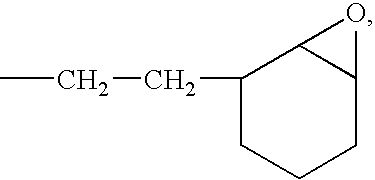Active Energy Ray-Curable Organopolysiloxane Resin Composition, Optical Transmission Component, And Manufacturing Method Thereof
- Summary
- Abstract
- Description
- Claims
- Application Information
AI Technical Summary
Benefits of technology
Problems solved by technology
Method used
Image
Examples
reference example 1
Preparation of Epoxy-Containing Organopolysiloxane Resin (A1)
[0045]A solution of a silanol-containing methylphenylpolysiloxane resin was prepared by subjecting a mixture of 505 g phenyltrichlorosilane and 47 g dimethyldichlorosilane to co-hydrolysis and condensation in a mixture of 500 g toluene, 142 g 2-propanol, and 142 g water. The solution was neutralized with an aqueous solution of sodium hydrogencarbonate and washed with water, which was subsequently completely removed under heating. 226 g 2-(3,4-epoxycyclohexyl)ethyltrimethoxysilane and 2 g of a 50 wt % aqueous solution of potassium hydroxide were added to the remaining solution, and water, methanol and toluene were removed by azeotropic dehydration under heating and agitation. In the process, an appropriate amount of toluene was added to maintain the solid matter concentration at about 50 wt %. Upon termination of the dehydration condensation reaction of silanol groups, the solution was additionally refluxed for several hour...
reference example 2
Preparation of Epoxy-Containing Organopolysiloxane Resin (A2)
[0046]With the exception of using 315 g phenyltrichlorosilane, 191 g methyltrichlorosilane, 55 g dimethyldichlorosilane, and 262 g 2-(3,4-epoxycyclohexyl)ethyltrimethoxysilane as the starting raw materials, a toluene solution (solid matter content: 490 g) of an epoxy-containing organopolysiloxane resin with an average unit formula of [Me2SiO2 / 2]0.10 [MeSiO3 / 2]0.30[PhSiO3 / 2]0.35[E3SiO3 / 2]0.25 was obtained by conducting reactions in the same manner as in Reference Example 1. The number-average molecular weight of the epoxy-containing organopolysiloxane resin was 3700, the phenyl group content was 32 mol %, and the total content of silanol and methoxy groups was 0.9 mol %. In order to use it in the working examples below, the toluene was removed.
working example 1
[0047]UV-curable epoxy-containing organopolysiloxane resin compositions 1 to 10 used for the cladding were prepared by mixing the epoxy-containing organopolysiloxane resin (A2) obtained in Reference Example 2 as Component (A), p-tolyldodecylphenyliodonium hexafluoroantimonate as Component (B), isopropyl-9H-thioxanthene-9-one (ITX), xanthone, anthrone, benzophenone, 4,4′-bis(dimethylamino)benzophenone (Michler's ketone), diethoxyacetophenone, and products from Ciba Specialty Chemicals such as Darocure 1173 (2-hydroxy-2-methyl-1-phenylpropane-1-one), Irgacure 184 (1-hydroxy-cyclohexyl-phenylketone), Irgacure 369 [2-benzyl-2-dimethylamino-1-(4-morpholinophenyl)-butanone-1] or Irgacure 651 (2,2-dimethoxy-1,2-diphenylethane-1-one) as Component (C), and anisol as Component (D) in a weight proportion of 100:3:0.6:40. In a closed-chamber system, the above-mentioned UV-curable epoxy-containing organopolysiloxane resin compositions 1 to 10 were spin coated on a silicon substrate by adjusting ...
PUM
| Property | Measurement | Unit |
|---|---|---|
| Percent by mass | aaaaa | aaaaa |
| Percent by mass | aaaaa | aaaaa |
| Percent by mass | aaaaa | aaaaa |
Abstract
Description
Claims
Application Information
 Login to View More
Login to View More - R&D
- Intellectual Property
- Life Sciences
- Materials
- Tech Scout
- Unparalleled Data Quality
- Higher Quality Content
- 60% Fewer Hallucinations
Browse by: Latest US Patents, China's latest patents, Technical Efficacy Thesaurus, Application Domain, Technology Topic, Popular Technical Reports.
© 2025 PatSnap. All rights reserved.Legal|Privacy policy|Modern Slavery Act Transparency Statement|Sitemap|About US| Contact US: help@patsnap.com



